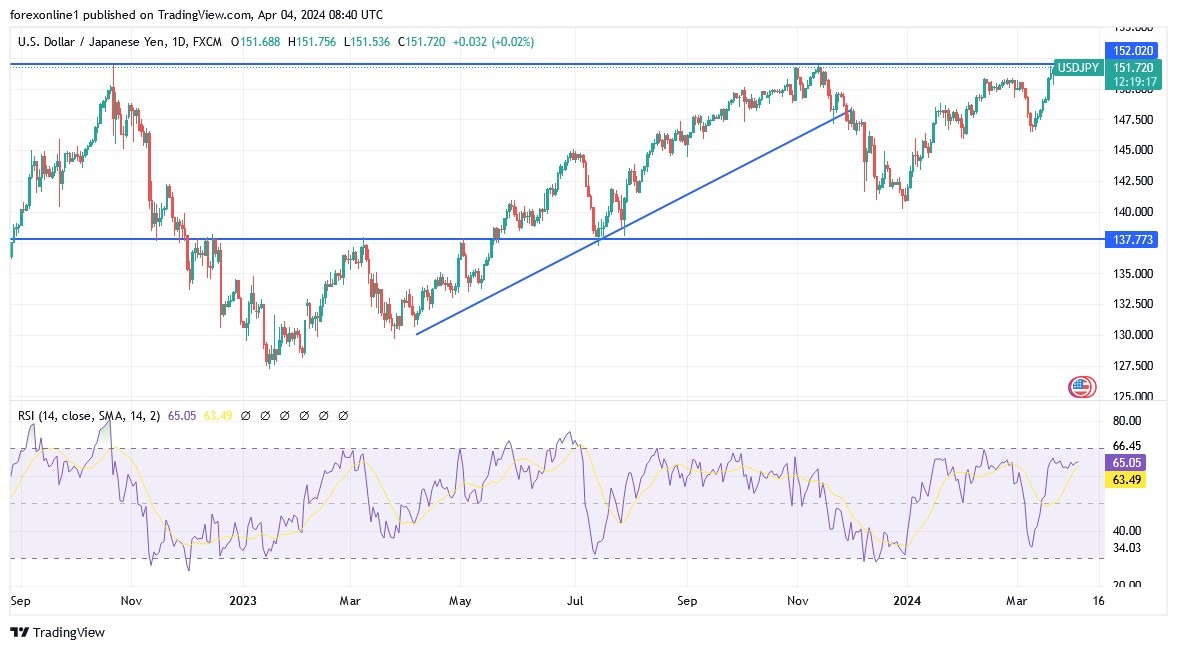- The first interest rate hike in Japan in 17 years failed to provide the support policymakers were hoping for, as analysts point to four main reasons for the currency's current weakness.
- This explains the continued upward trend for the USD/JPY currency pair following the historic decision, stabilizing around the resistance level of 151.90, hinting at potential Japanese intervention levels in the markets.
- At the top of the list of reasons for the yen's continued decline are Japan's interest rates, which remain much lower than the rest of the world.
It is followed by speculation that the yen has not weakened fast enough to warrant intervention, decreased market volatility favouring carry trades, and signs of declining currency values not boosting exports. Meanwhile, officials have stated that the yen's rate does not align with fundamentals and that they will take appropriate steps to halt declines, the currency remains near its lowest level in three decades at 151.97 against the dollar, which it reached last week.
Furthermore, yields are low. After adjusting for inflation, the yield on 10-year Japanese bonds is around -0.650%, compared to around 2% in the United States and 0.27% in Germany. This provides a significant incentive for traders to borrow the Japanese yen to invest in higher-yielding assets in a strategy known as carry trade. It's a headache for the Japanese government, which must deal with the political ramifications of a weak yen, leading to increased living costs for households.
While the Bank of Japan is expected to raise borrowing costs further this year as its major peers begin cutting interest rates, the exact timing is uncertain, and it will take some time to narrow the country's widening yield gap with its peers.
Additionally, there's uncertainty about intervention. Currency traders are on high alert for potential yen-supporting interventions by the Japanese Ministry of Finance after officials intensified their warnings. However, the leap from words to actions seems significant. Therefore, traders are focusing on measurable guidance from the top government currency official, Masato Kanda, and are looking for movements of 10 yen over a one-month period against the dollar as a key gauge.
Overall, according to forex trading platforms, the yen has not moved much in recent weeks, according to a measure that gauge’s currency volatility from its highest to lowest levels against the US dollar in a rolling 28-day window. The last time the dollar against the yen reached this threshold was in October 2022 when the Ministry of Finance intervened twice. It is now less than half of that level.
Accordingly, analysts suggest that Japanese intervention would target a rise to the 155-yen mark. Japan adheres to international agreements calling for governments to allow markets to determine exchange rates. However, there is room for intervention in response to excessive movements.
In addition, volatility in the forex market has declined, which has added to the attractiveness of carry trade for investors, who do not have to worry about market volatility wiping out profits. Leveraged funds and asset managers together pushed bearish bets on the yen to their highest level since April 2022 last month, according to data from the Commodity Futures Trading Commission. Also, JPMorgan Chase & Co's measure of global currency volatility has halved from its recent peak in September 2022.
Top Forex Brokers
Meanwhile, there has been a decline in Japanese exports. Economics textbooks say that a weak currency should boost exports by making products more affordable overseas, and that foreign demand should eventually strengthen the currency. However, that is not happening in Japan right now, with exports failing to gain momentum. Overall, the yen's nominal effective exchange rate, a measure of the currency's strength against its major trading partners, has fallen by about 25% since the end of 2020. Moreover, the Bank of Japan's measure of inflation-adjusted exports fell by 3.3% during that period.
Furthermore, this may reflect that Japanese companies are increasingly producing goods overseas rather than exporting, while outflows of funds from the country to seek higher investment returns abroad are also a headwind for the yen. Improving the trade balance should be part of the currency adjustment process.
USD/JPY Technical Analysis and Expectations Today:
We expect the overall trend of the USD/JPY currency pair to continue until there is a strong reaction to the US jobs figures at the end of the week or an expected Japanese intervention in the markets to prevent further collapse of the currency price. Currently, the nearest resistance levels for the trend are 152.00, 152.55 and 153.20 respectively.
Ready to trade our daily Forex analysis? We’ve made a list of the best forex trading accounts worth trading with.


